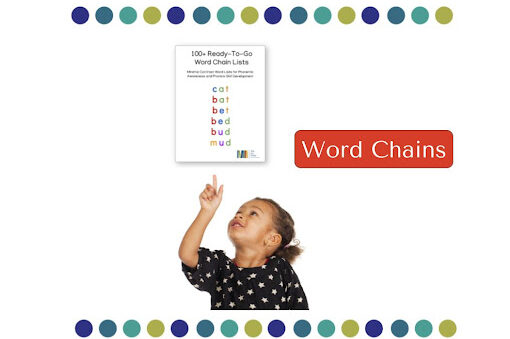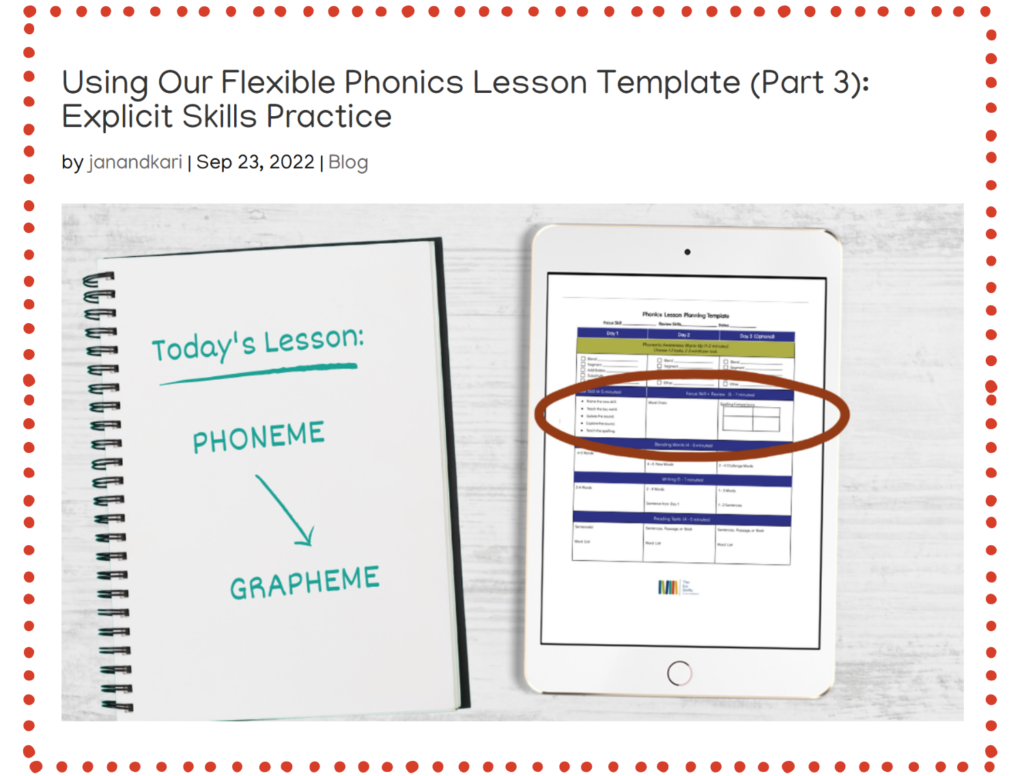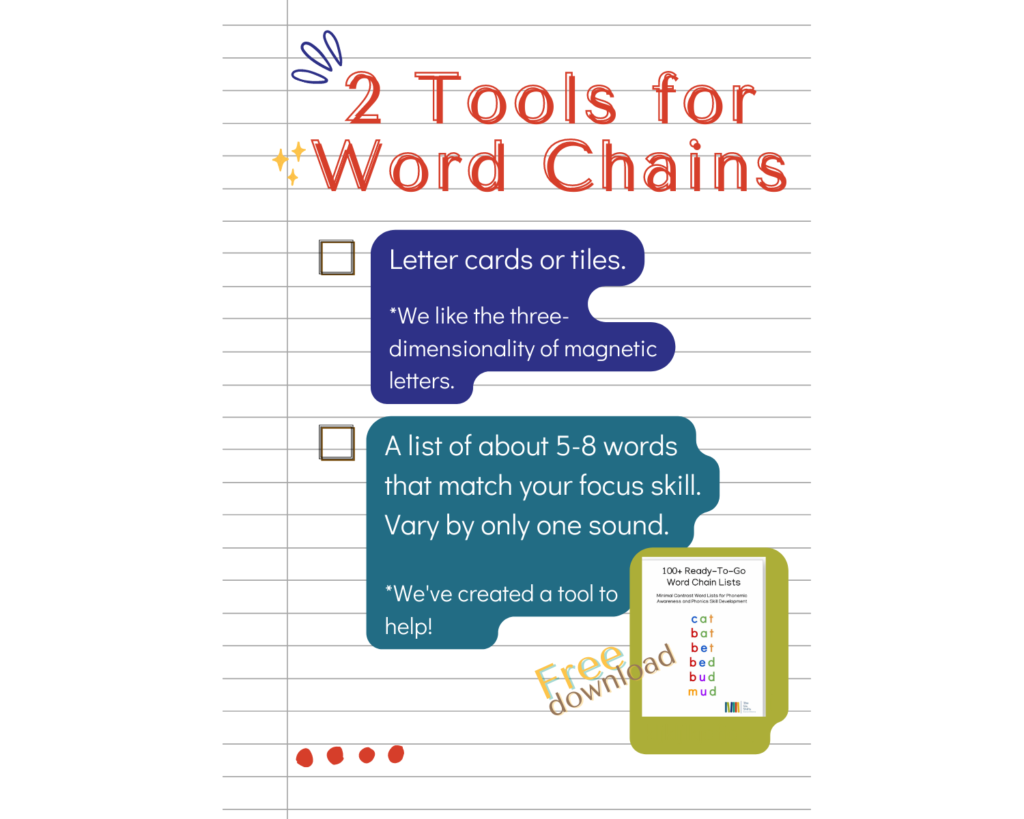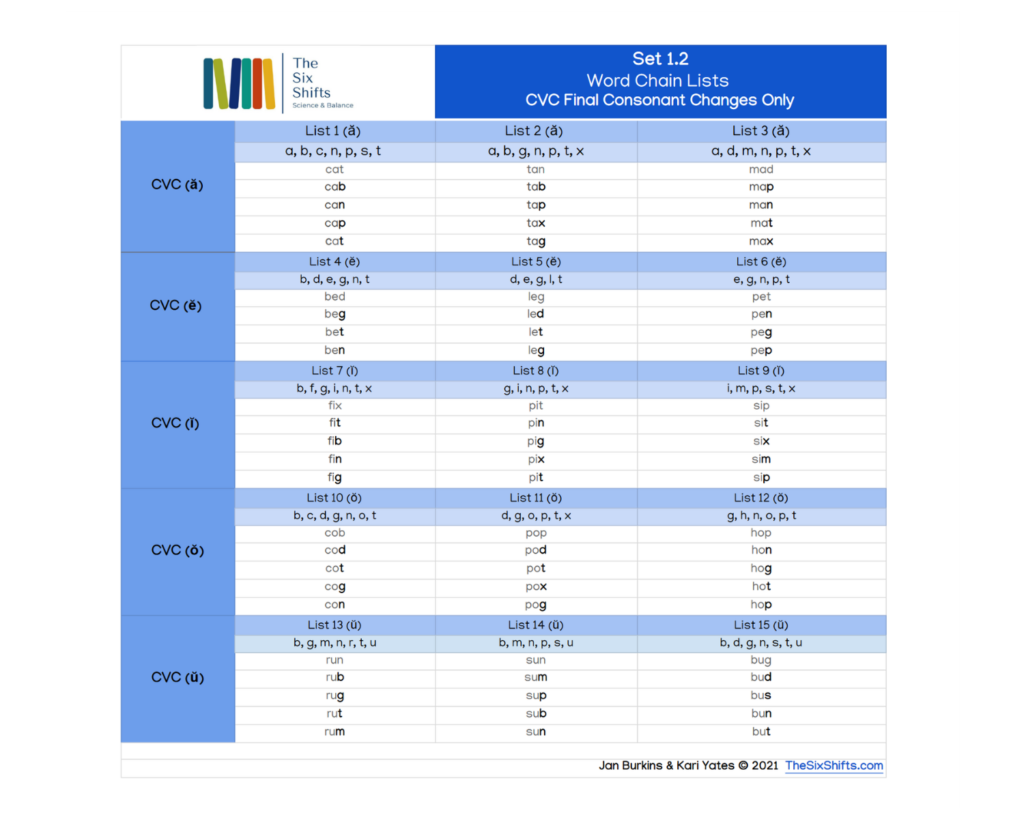After our last blog series exploring each component of our Explicit Phonics Lesson Template, we knew we had to revisit one component in particular: Explicit Skill Practice. In our initial post about this lesson component, we looked at the focused skill practice from Day 1, which provides a detailed and multi-sensory introduction to the focus sound and its spelling.
More than any other lesson component, explicit instruction, the second component of the lesson template (circled above), has an entirely different routine each day of the 3-day sequence. Here’s how this component unfolds across the three days of the lesson:
Day 1 – Children learn the new skill with a routine that is explicit and multi-sensory. (We zoomed in on Day 1 in this post.)
Day 2 – Children manipulate sound-spellings (new and reviewed) through word chains. (This is going to be our focus today.)
Day 3 – Children compare words containing the new and review sound-spellings. (That will be our focus next time!)
Word chains are one of the most powerful ways to help students deepen their phonics and phonemic awareness skills simultaneously. This week, we offer guidance on leveraging this engaging routine and share some TOOLS we’ve created to help you get started teaching with word chains.
When students work with word chains, they perform two tasks. First, they build or write a word dictated to them and then change one sound-spelling to transform it into a new word.
Building word chains requires students to apply phonics skills and draw heavily on phonemic awareness, calling on students to segment, blend, analyze, compare, delete, and substitute sounds.
In other words, word chains are one power-packed multi-sensory practice!
TARGET PHONICS SKILL + PHONEMIC AWARENESS = POWER-PACKED PRACTICE
Let’s get started.
First, gather your materials. For a 3- dimensional, multi-sensory experience, we suggest magnetic letters. However, if you don’t have access to enough magnetic letter sets for each child, they can also build words with letter tiles or cards or write with markers on dry-erase surfaces.
What you can’t use word chains without, however, is a thoughtfully designed list with words containing several examples of previously taught phonics skills (either recently or in the past) AND that only require one phoneme/grapheme substitution to “chain” from one word to the next (cap, can, fan, fun, run, ran). These lists are sometimes called minimal contrast lists.
To save you some time, we’ve put together a free collection of 100+ Ready-To-Go Word Chain Lists. We hope it gives you a head start with this fun and powerful routine. Take a look at a sneak peek in the image below!
Tell students that they will use tools today to practice building words with the new sound-spelling as well as some that are familiar. If using manipulative letters, you can simplify the task and make management more efficient by giving or telling students the letters needed to chain today’s words. If you’re fortunate enough to have individual letter trays for each student, this will help them know which letters to pull off the tray.
Here is some language for introducing the task:
“Today, we’re going to build a word chain.”
“You will need the following letters c, h, i, o, a, p, t.”
2. Pronounce and define the first word.
Say the first word clearly to students. Then, define and/or use it in context. You can even have students repeat the word after you in unison to make sure they understand.
Here is some language for pronouncing and defining the first word:
“The first word is chat.”
“Chat means to talk. I had a chat with my neighbor about her garden.”
“Build the word chat. “
3. Build and check the first word.
While building the word, students should be a bit “noisy.” You want to hear and see them actively working across the word, segmenting it as they match the phonemes (sounds) to the correct graphemes (letters).
After students have had time to build the word, offer a model by writing or building the word on a board for all to see.
Here is some language for building and checking:
“Build chat now.” (Observe and scaffold as students work.)
“Watch as I write/build chat.” (Write chat on the board or build with your own set of letters.)
“/ch/-/aa/-/t/” Blend through the word, pointing to each grapheme, and then pronounce the word.
“Now look at how you spelled chat. Is it correct? If not, fix it up.”
4. Prompt for word change.
Now it’s time for a new word. Remember, students only need to change one sound-spelling! In this routine, you say the new word, and the students analyze which sound changes, and which grapheme to trade out. This is a phoneme manipulation task including segmenting, deleting, adding, AND blending. All the while, students will continue to map those sounds to their corresponding graphemes. A small routine, providing POWER PRACTICE!
Here is some language for prompting a word change:
“Now change chat to chap.”
“A chap is a boy.”
“Listen as I use the word chap in a sentence: He was a funny chap.”
5. Repeat the process. ☺️
Repeat steps 2, 3 & 4 above for five-eight words. You can expect this routine to take 5-7 minutes.
There you have it! This powerful 5-step process packs a punch with the dynamic pairing of phonics and phonemic awareness, providing practice with both the current focus skill and a cumulative review of past skills.
You can even make word-building activities simpler or more complex based on the needs of your students. “What’s The Word?” provides a simplified alternative for adapting this task. You can read more about it in Shift 3 of Shifting the Balance.
Bonus: You can use this routine during whole group, small group, or one-on-one instruction, and it can work with any phonics skill.
Don’t forget to pick up the download to simplify your planning for word chains.
We hope to see you back next week as we dig into the Day 3 routine, Word Comparisons.
Explore our 8-part blog series “Using our Flexible Phonics Lesson Template.”👇
Using Our Flexible Phonics Lesson Template (Part 1): An Introduction
Using Our Flexible Phonics Lesson Template (Part 2): The Phonemic Awareness Warm-up
Using Our Flexible Phonics Lesson Template (Part 3): Explicit Skills Practice
Using Our Flexible Phonics Lesson Template (Part 4): Blending Words
Using Our Flexible Phonics Lesson Template (Part 5): Writing
Using Our Flexible Phonics Lesson Template (Part 6): Reading Text
Using our Flexible Phonics Lesson Template (Part 7): Word Chains
Using our Flexible Phonics Lesson Template (Part 8): Spelling Comparisons
-
Jan Burkins and Kari Yates are authors, speakers, and consultants, who are dedicated to helping teachers around the world translate reading science into simple instructional moves that help teachers make learning to read easier for their students while still centering meaning-making, engagement, and joy.
Recent Posts






Our graduate class is using your text to learn about science-aligned literacy practices. The group who facilitated our class’s understanding of Shift Three- Reimagining the Way We Teach Phonics focused on word chains. I just shared this particular blog with them. We find your book and the resources you provide quite valuable!
So glad to hear it has been helpful. Word chains pull together so many critical skills for practice!
This is great to hear. We are big fans of word chains because they tie so many critical literacy skills together!